Article
Small Ship Cruising: Alaska by the Back Door
Author(s):
Alaska is not built to human dimensions: Visitors cannot enjoy it in one big bite -- they have to take it a nibble at a time. A good start would be a small ship cruise of South East Alaska, home of the Baranof Warm Springs.
Photography by the authors

Alaska looms large. Texas, used to boasting how big it is, basically became downsized when Alaska joined the 48 states. Alaska is not built to human dimensions: Visitors cannot enjoy it in one big bite; they have to take it a nibble at a time.
A good start would be a small ship cruise of South East Alaska, that panhandle that creeps up the coast to the west of British Columbia for 520 miles, until it runs into Icy Bay and the rest of this Great Land.
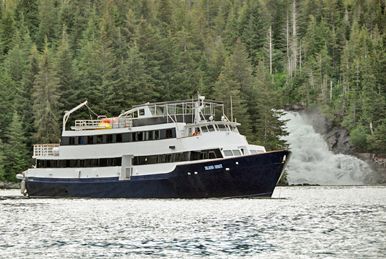
Jeff Behrens owns and captains such a small ship, the Island Spirit. It bobs lazily at anchor now in Baranof Warm Springs Bay, a community of a dozen seasonal residents 30-60 minutes from Sitka -- if we were on a float plan. Fortunately, we are not; we’re on a 128 foot-long ship whose maximum speed is 17 knots. It’s taken us half a day to get here from Sitka and that’s the way we want it, the only manner to see those remote areas of Alaska, many of which are stories in themselves.

Asked to compare his cruise to those of the ocean liners, Captain Jeff replies, “I take my 32 passengers into locations only one percent of visitors to Alaska will ever see. The big ships take thousands of tourists into places where they can go shopping!”
We set off in an inflatable moments later -- and we ain’t goin’ shoppin’! We’re on our way to climb 500 yards up a steep slope to find why this part of Baranof Island is called Warm Springs. The answer comes easy and we’re enjoying water at 107 degrees after a hike that might give pause to any candidates for a total knee replacement. The ice-cold river cascades down the slope behind us as we raise our glasses to Richard Tanner, the ship’s naturalist who, today, would appear to be giving us champagne as well as nature talks.
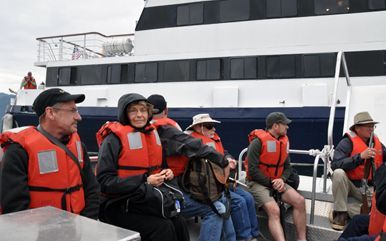
Richard’s talks included the story of glaciers, the history of whales and the life of John Muir. He also put on movies, such as the PBS Alone in the Wilderness and Out to Sea with the grumpy old men, Jack Lemmon and Walter Matthau -- and, not at all grumpy, Dyan Cannon.
We also had the luck to have John Greengo, a professional photographer aboard for a series of fascinating illustrated talks on how to improve our own photography. John’s enthusiasm was infectious. He soon got us to agree with his remark: “Photography is the coolest thing in the world,” even as he showed us an image of a traveler overburdened with needless photo equipment.
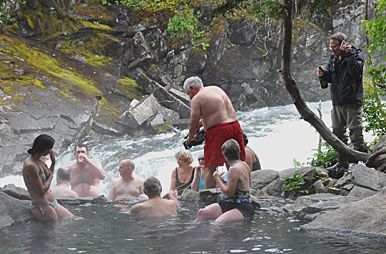
We were busier taking our own pictures than watching movies, however. We had plenty of opportunities when a humpback chose to go fishing on a solo expedition. He appeared early and immediately attracted attention.
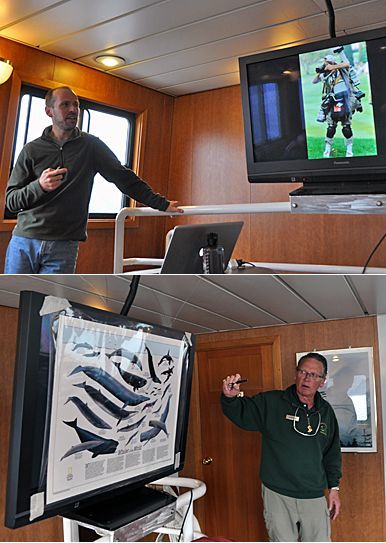
The humpback worked subsequently, by himself, by diving down and then making a circle while blowing bubbles that ascend trapping confused fish within the column. The whale then swam up with his mouth open to feed. This he did many times, each time our cameras getting busy. The whale stayed busy, too, as he needs 1½ tons of food a day to survive.
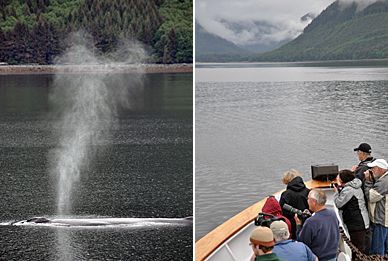
Tanner’s whale talk answered many of our questions about those magnificent animals. Says he, “Thirty years ago the only information we had about whales was how to kill them! Now we have a better understanding -- such as, ‘How do they sleep without drowning?’ Turns out they shut down one cerebral hemisphere at a time to remember they have to come up to breathe even as they sleep.”
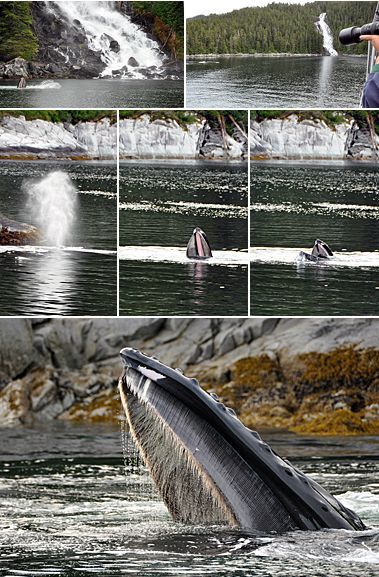
“Why do they breach?” we ask.
“Some mysteries may be better kept,” he replies then suggests they do it to get rid of barnacles. Or to get their bearings or perhaps for fun. Then Tanner grins and says, “Maybe they just fall out of the water!”
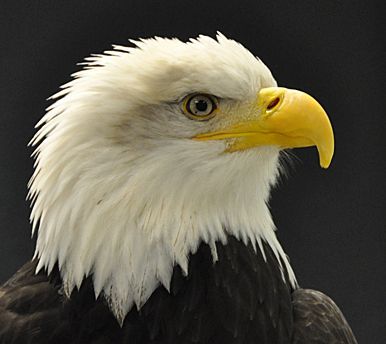
We saw plenty of birds falling into the water. Gulls and bald eagles. The eagles often hunted in pairs, but moved so fast they were hard to photograph. “If you see it, you’ve missed it,” says Greengo, our photographer.
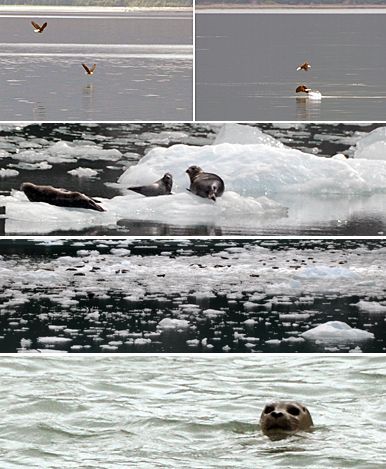
We didn’t miss harbor seals lolling with their pups on ice floes. Their predators, orca whales, navigate by a kind of radar, but it’s believed the image the orcas get from below is just of the floes themselves, not the figures lying on top -- so as long as the floes hold, the seals are relatively safe.
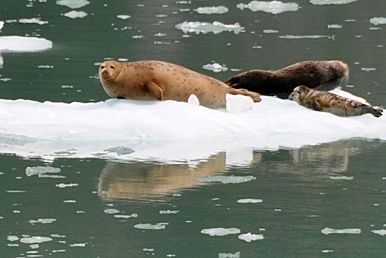
The Island Spirit keeps its passengers safe, too. We had a woman aged 93 on board with her daughter and son-in-law, and a man aged 90 with his son. They tackled everything successfully, but it was heart-warming to see the extra care the crew gave those older passengers.
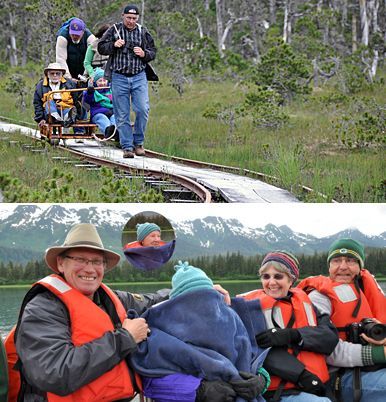
On an excursion to the remote Oliver Inlet State Marine Park, the crew reactivated an old railway (pump trolley) cart for the rail and boardwalk trip across the muskeg bog to an isolated cabin still used by hikers. Coming back, one of the younger passengers felt the elderly lady might be cold and, over her protests, wrapped her in a blanket.

Our ship’s captain, himself always there to help, declared his greatest satisfaction was helping elderly passengers see the part of Alaska that so enchants him. There was a lot to see, from kayaking to cheering the crew when they dared to jump into the frigid water around us. Whatever we did, we found great meals waiting when we returned to the ship -- especially for Sunday brunch.
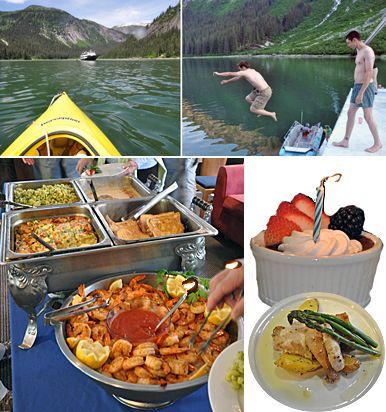
What else did we see? Well, waterfalls for sure, several where the captain got rid of passengers and photographers from his bridge then nudged his ship so close into the actual water flow that Steve, one of the crew, filled a jug from water as it cascaded down the cliff from ice several hundreds to thousands of years old.
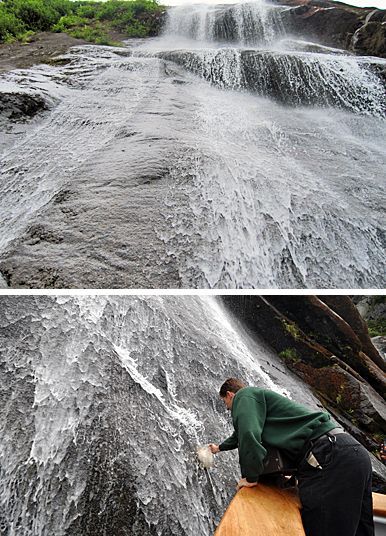
We visited four cities and communities all of them interesting enough to be stories in themselves from tiny Tenakee Springs with its 90 residents to Juneau with its 30,000 (the state capital and third smallest in the USA after Sioux Falls in South Dakota with its 20,000 and the smallest, Montpelier in Vermont struggling to produce 8,000).
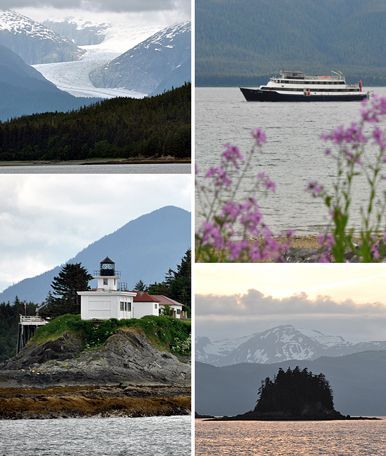
We called on the Five Fingers Lighthouse, now with a seasonal lighthouse keeper, the last in our country to be manned by a human. And -- equaling the thrill of the humpback whale — we went up to the great Dawes Glacier, a mile wide and 250 feet high at its face. It lies 30 miles in at the end of Endicott Arm. The so-called katabatic wind (one that blows down an incline) that whistled over the glacier surface and into our ship reminded us we were in Alaska. It ultimately chased us back into the lounge of the Island Spirit and the serenity of being spoiled while sailing in South East Alaska.
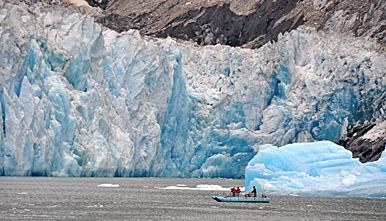
The Andersons, who live in San Diego, are the resident travel & cruise columnists for Physician's Money Digest. Nancy is a former nursing educator, Eric a retired MD. The one-time president of the New Hampshire Academy of Family Practice, Eric is the only physician in the American Society of Travel Writers. He has also written five books, the last called The Man Who Cried Orange: Stories from a Doctor's Life.




